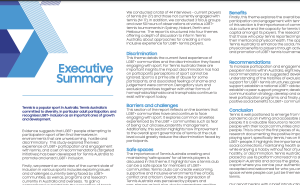4 The marketing plan
Disclaimer: This weeks focus on a marketing plan framework will serve as the foundation for your marketing proposal that you will be submitting as part of your course assessment. You may be wondering why we’re discussing it so far in advance, but trust me, it’s for a good reason!
By having a clear understanding of the assignment requirements early on, you’ll be able to fully grasp the weekly content and see its relevance to your overall plan. Think of each week as building up to the big event, just like how each training session leads to a winning game. So don’t drop the ball and stay focused on the end goal! It might be a good idea for you to have a look at the assessment instructions for the portfolio ahead of this week.
Learning Objectives
- To understand the importance of an executive summary in a marketing plan and how it summarises the key elements of the plan.
- To begin analysing the environment in which the sports organisation operates and the factors that impact its marketing efforts
- To explore the specific, measurable, attainable, relevant, and time-bound marketing objectives for the sports organisation
- To be aware of the importance of effective marketing strategies that align with the organisation’s goals and target audience
- To understand the need to evaluate the success of the marketing plan and make modifications as needed to ensure that the objectives are being met.
Introduction
Success in the sports industry requires a strong plan to promote and sell products, services, and events to the target audience. A well-structured marketing plan plays a crucial role in this effort. In this chapter, we’ll be exploring a marketing plan framework developed by Paul Blakey in his book on Sports Marketing (2011) and expanding and extending it to the example of the Australian sporting market. This framework encompasses several essential components, including an executive summary, analysis of the environment, marketing objectives, strategies, resourcing requirements and evaluation.[1]
Executive Summary
A marketing plan’s executive summary is a short overview of what the plan covers. It explains the purpose of the plan and outlines the main points that follow. Essentially, it’s like a summary of a summary!
An executive summary for a sports marketing plan should provide a succinct overview of the key elements of the plan. It should include information for your reader (or marker!) on the target audience, the objectives of the marketing campaign, the strategies and tactics that will be used to reach those objectives, and an overview of the budget and timeline for the campaign.
Additionally, it should provide a brief overview of the competitive landscape and the unique value proposition of the sports team or brand being marketed. It’s important to remember that the executive summary should be a “home run” in terms of catching the reader’s attention and making them want to dive into the details of the full plan. Just like a great play on the field, the executive summary should highlight the excitement and potential impact of the marketing plan. Keep it short, succinct and focused!
There are plenty of examples of good ‘executive summaries’ of research reports. Have a look here at one I found online which was published by Women in Sport (affiliated with Sport England) titled: Reframing Sport for Teenage Girls: Tackling Teenage Disengagement (the full report is available here[2])

As an academic who works in this space, I have written my fair share of executive summaries. Our executive summary had some important statistics, insights into what’s happening across the different clubs, and some suggestions for what Tennis Australia can do to be more inclusive. The goal was to give the reader a quick but solid understanding of what’s important and what needs to be done to make tennis more inclusive for all members of the community!
You can see the full open text on the research here but below is a photo of the ONE PAGE executive summary of this huge report![3]

If you’re still struggling with putting together your executive summary, don’t worry, there are plenty of resources out there to help you. In addition to the research project executive summary I mentioned earlier, you should also check out the video below[4] for more guidance on this section of your marketing plan. There is also more resources on the vUWS site to help you ahead of your assessment submission!
Background to the Plan
The background section explains why the marketing plan is important for the sports organisation. It should also describe what the plan covers and what the organisation wants to achieve through its marketing efforts. What kinds of things might you want to include in your “background” section of your marketing plan?
In order to paint a clear picture of the situation, it’s important to include specific information in the background section. For example, you might include demographic data about the area, such as information on the age, gender, education, income, and cultural and social experiences of the people who live there. Additionally, you could provide an overview of the values of the sports teams in the area and how they align with or differ from the values of the community they are located in.
Data sets from sources such as the ABS can provide valuable insights into the broader context of the environment (don’t worry we explore this in Week 6- Market research in the sport industry). Information about community engagement and how the sports teams in the area are involved in the community, as well as how they are perceived by local residents, is also important to include.
By including all of this information in the background section of your proposal, you create a comprehensive and well-informed picture of the environment in which your strategy will be implemented. Having this clearly explained will provide a strong foundation for the rest of the proposal and helps to ensure that your strategy is data-driven and well-informed.
In class this week we will segment Sydney into four sections Northern Sydney, Western Sydney, the Sutherland Shire and Sydney City! As the assessment instructions suggest, you will be assigned one area and a specific Rugby League team to form the basis of your marketing plan. Whilst we are drilling down into Sydney, Sydney itself has its own culture- have a look at this video by comedian Jimmy Rees[5] for some insights before we head into class.
Environmental Analysis
The environmental analysis is all about understanding the factors that can impact the sports organisations marketing efforts. This includes looking at both internal and external factors, like the competition and the target market. A SWOT analysis and market research are also done as part of this step.
As the above video[6] explains, SWOT Analysis is a marketing tool that helps organisations identify and understand their strengths, weaknesses, opportunities, and threats. It is a strategic method used to evaluate the internal and external factors that can impact a business. In the context of sports within Australia, a SWOT Analysis can help a sports organization determine its position in the market and identify areas for improvement. See below for a full breakdown that has been adapted to the definitions provided by Lee and Walsh (2011)[7]
By conducting a SWOT Analysis, any sport team can get a better understanding of its position in the market and identify areas for improvement. This information can then be used to develop a strategic plan that capitalises on the organisation’s strengths, addresses its weaknesses, takes advantage of opportunities, and (understand) then minimises threats.
Case Study: The argument for hosting events in Australia
This week we will be debating in class using the SWOT tool to understand how hosting mega events, such as international sporting competitions or large-scale cultural festivals, can bring both positive and negative impacts to a region. It is important for you to understand and identify these impacts as they play a crucial role in decision making and event planning. Check out the above video[8] for context
Also, one of this weeks extended readings is by Kostas Karadakis et al. (2010) called Event leveraging of mega sport events: a SWOT analysis approach[9].
Marketing Objectives
The marketing objectives section of a sports organisation’s marketing plan serves as a crucial component in outlining the foundation for the entire marketing strategy. By establishing specific, measurable, achievable, relevant, and time-bound (SMART) goals [10], the organisation can effectively allocate its resources and efforts towards realising these objectives. Watch the below video [11], noting we will be going through these more in class this week!
Marketing Strategies
The marketing strategies section of your marketing plan will outline the approach the sports organisation you have chosen will take to achieve its marketing objectives. This includes identifying the market segment and target market, figuring out what makes the organisation unique (its unique selling proposition to this market), and deciding how to promote and sell its products and services (the marketing mix). A good friend of ours Blair Hugh’s has set up a website where he is tracking all the fun, exciting and unique marketing strategies of sport organisations all over the world – you can check out his website here .
Next week, in Week 5 (Market segmentation and target marketing) we explore target marketing and marketing segments within the sports industry. This focus will enable for you to be able to address this section of the marketing plan and understand how what you design and create needs to not only hit a brief, but hit a brief with a particular demographic.
Resourcing Requirements
The resourcing requirements section explains what resources the sports organisation will need to put its marketing plan into action. This could include things like a budget, personnel, and equipment.
The budget is a vital resource that should be included in the resourcing requirements section. It should detail the cost of each marketing activity and the overall cost of the marketing plan, taking into account any potential cost overruns and contingencies. The budgeting process in sports marketing can have a big impact on the success of the marketing strategy. You need to get the resources they need and make decisions about how to allocate those resources among different marketing activities. To make sure the budget supports the marketing strategy, those responsible for the budget should understand how to use the organization’s financial resources effectively. The budget should give priority to activities that support the strategy, but not waste resources by over-allocating funds. The budgeting process may also need to change in response to unexpected events or changes in strategy[12].
Personnel, both internal and external, are an important resource that should be considered. This section should outline the roles and responsibilities of each individual involved in executing the marketing plan.
Equipment and technology, such as data capturing software, hardware, and production equipment, should also be included in the resourcing requirements section. The section should specify the type and quantity of equipment required for each marketing activity.
A timeline for implementation is also a critical resource, outlining the start and end dates for each marketing activity and the overall timeline for the marketing plan. This helps to ensure that the marketing plan is executed in a timely manner and that all activities are completed as scheduled.
Have a watch of this video that explains “what’s wrong with sports marketing” [13] from over 10 years ago. Let’s see if the same “problems” still exists today?
We will go through this is more detail in Week 10 (Sponsorship, corporate partnerships and sponsors) and Week 11 (Community and Stakeholders), but keep these things at the back of your mind at the point of thinking about how you are going to market to your group. We encourage you to be ambitious – but you need to think about how much input will be required for your strategy to thrive!
Control and Evaluation
The control and evaluation section is the heart of any marketing plan. Here’s where the sports organization will track its marketing success using metrics like ticket sales, merchandise sales, sponsorship revenue, and ad campaign effectiveness. With these results, the organization will tweak its marketing plan to ensure it’s on track to hit its goals. This section is arguably the MOST crucial part of any marketing plan. Why? Having clear, measurable objectives is key to success. Find out more in Week 9 when we dive into (Promotion and Sales).
Media Attributions
- Blakey, P 2011, Sport marketing, SAGE, Exeter, UK. ↵
- Sport England 2022, Reframing sport for teenage girls: Tackling teenage disengagement, Women in Sport, <https://womeninsport.org/wp-content/uploads/2022/03/Tackling-Teenage-Disengagement-March-2022.pdf> ↵
- Storr, R, Richards, J & Curro, G 2020, Game on: LGBT+ inclusion in Australian tennis, Tennis Australia, <https://researchdirect.westernsydney.edu.au/islandora/object/uws:58017/> ↵
- Young Entrepreneurs Forum 2018, How to write an executive summary for your business plan?, 26 November, online video, <https://www.youtube.com/watch?v=PXoE2wMvTVE> ↵
- Rees, J 2023, Border Control for Sydney ... you wanna go in? 🥴, 8 February, online video, <https://www.youtube.com/watch?v=F_6EwCVpcsQ>. ↵
- SmartDraw 2018, SWOT analysis - What is SWOT? Definition, examples and how to do a SWOT analysis, 8 August, online video, <https://www.youtube.com/watch?v=JXXHqM6RzZQ> ↵
- Adapted from Lee, S & Walsh, P 2011, 'SWOT and AHP hybrid model for sport marketing outsourcing using a case of intercollegiate sport', Sport Management Review, vol. 14, no. 4, pp. 361-9. ↵
- Sky News Australia 2023, ‘Petty’ rivalry between states over hosting sporting events is ‘exhausting’, 5 February, online video, <https://www.youtube.com/watch?v=iI-P9FbLgbU>. ↵
- Karadakis, K, Kaplanidou, K & Karlis, G 2010, 'Event leveraging of mega sport events: a SWOT analysis approach', International Journal of Event and Festival Management, vol. 1, no. 3, pp. 170-85. ↵
- Da Silva, EC & Las Casas, AL 2017, 'Sports marketing plan: an alternative framework for sports club', International Journal of Marketing Studies, vol. 9, no. 4, pp. 15-28. ↵
- Marr, B 2021, How to set SMART goals & objectives, 31 August, online video, <https://www.youtube.com/watch?v=pdPtuhZiSq4>. ↵
- Shank, MD & Lyberger, MR 2014, Sports marketing: A strategic perspective. Routledge, London. ↵
- Forbes 2011, Problems with sports marketing, 16 June, online video, <https://www.youtube.com/watch?v=TEW648hPABI> ↵

